Episode 1: Systems Thinking for Healthier Soil


Very little in this world is all or none and soil health protocols are no different. There is no one size fits all for every operation. “There’s a grey area in between that needs to be addressed” says Woody Van Arkel, a farmer in Ontario. Woody shares that some crops, specifically vegetable farming, require special handling and field management that cannot exclude all tilling practices. This resonates well with Central Crop Consulting Agronomist Dr. Lee Briese.
“I work with enough farmers that do a lot of different things and you understand right away that there’s more than one way to do things. ….The goal here is to produce a crop and do it well while protecting the resources.” – Lee Briese
Lee recommends having producers create well defined “clear and attainable” goals such as managing water, managing soil or reducing erosion. While profitability is the underlying mission that isn’t specific enough to focus your efforts. A well-framed goal will create a measurable benchmark to better evaluate for change and success. Lee also cautions producers from “painting themselves into a corner” by prematurely picking the cover crop they would like to start with. He recommends considering what herbicides you want to use and how the residue will be managed and then determine the cover crop that best fits that program. Being flexible and considering long term planning with outcomes is critical to the success of new practices. While using these recommendations, Woody has been persuaded to choose a different cover crop mix than he would have otherwise.
“The goal is maybe not so much cover crop diversity as getting the living root system established that works. A practical system that works for the biggest part.” – Woody Van Arkel
The collaboration of Woody and Lee has created a healthy dynamic of seeking advice and not just validation. Because every situation and operation is unique they bounce ideas off of each other in order to decide what would be the best fit towards Woody’s goals.
“Using my scientific background and my experiences to try to…reduce his risk is really the way I see this for growers is just trying to make things fit so that it fits their farm, their machinery, their timing, their goals, to reduce their risk.” – Lee Briese
This Week on Soil Sense:
Meet Woody Van Arkel a farmer in Ontario.
Explore the collaboration created between him and agronomist Dr. Lee Briese. Learn the philosophy these two share in regards to soil health practices
Connect with Soil Sense:
Soil Sense Podcast is hosted by Tim Hammerich of the Future of Agriculture Podcast.
Episode 2: Stories of Soil Health with Gil Gullickson
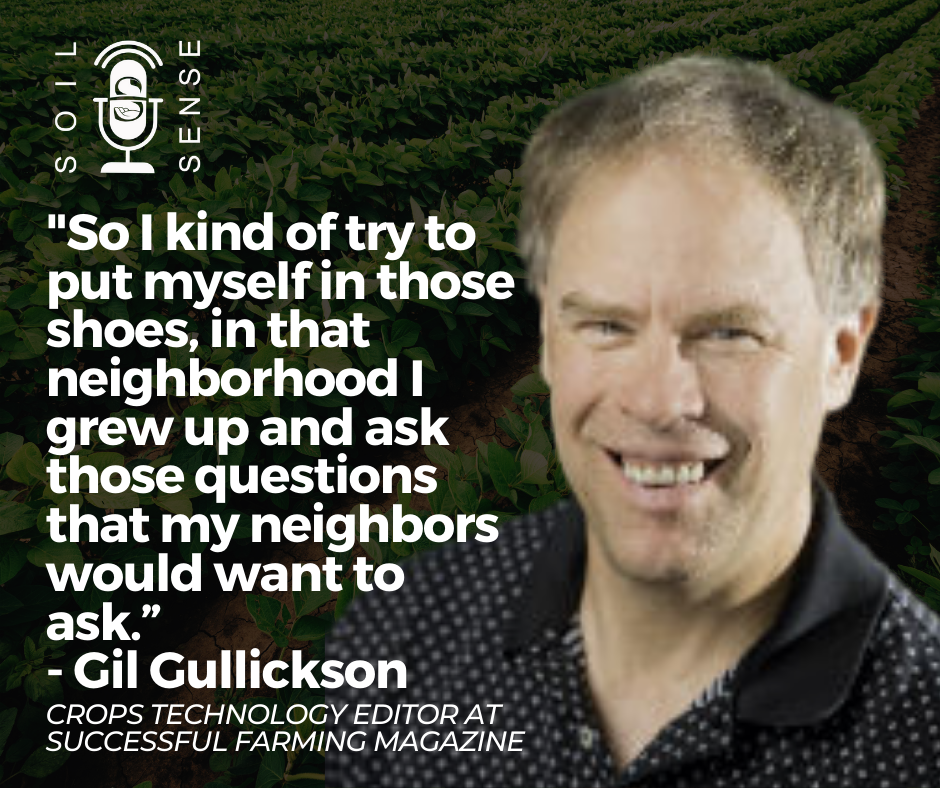
Gil Gullickson is the Crops Technology Editor at Successful Farming Magazine. Over the last three decades he has reported on agriculture in multiple publications. He has the benefit of having years of experience studying and discussing movements and changes in agriculture. Gil grew up on a farm in South Dakota. That background has greatly influenced his reporting style.
“So I kind of try to put myself in those shoes, in that neighborhood I grew up and ask those questions that my neighbors would want to ask.” – Gil Gullickson
Gil has been able to watch, reflect and report on the incorporation of soil health building practices into operations. Apart from the soil health benefits he has seen farmers gain more financial flexibility by pursuing soil health initiatives with year round cropping and calls it a “phenomenal impact.” Gil said he has observed that many of these soil health changes made over time have been a welcomed by-product of a focus on better water management practices.
“It’s not about no-till, it’s not about cover crops. It’s not about diverse rotations. It’s not about soil microbes. It’s not about bio-engineered soil. It’s about water management and these are all tools that enable farmers to better manage water.” – Gil Gullickson
Some operations not only improve their soil health but can save money from the onset in some soil health practices. Gil shares the significance of a great idea or movement taking time to marinate, develop and grow. He uses the example of an article he published called “Surefire Ways to Sustain Your Farm” that evolved overtime by gathering different farmers’ perspectives. He maintains that when evaluating technology the bottom line has to be prominent in the decision making.
“When you’re adopting technology make sure it’s going to return investment on your farm.” Gil Gullickson
This Week on Soil Sense:
- Meet Gil Gullickson a seasoned agriculture journalist who currently works as the Crops Technology Editor at Successful Farming Magazine
- Gil reflects on the changes and trends in soil health over the last few decades
- Explore the many reasons farmers get involved in soil health practices that extend beyond the benefits to the soil itself
Connect with Soil Sense:
Soil Sense Podcast is hosted by Tim Hammerich of the Future of Agriculture Podcast.
Episode 3: Interseeding Cover Crops for Livestock Forage

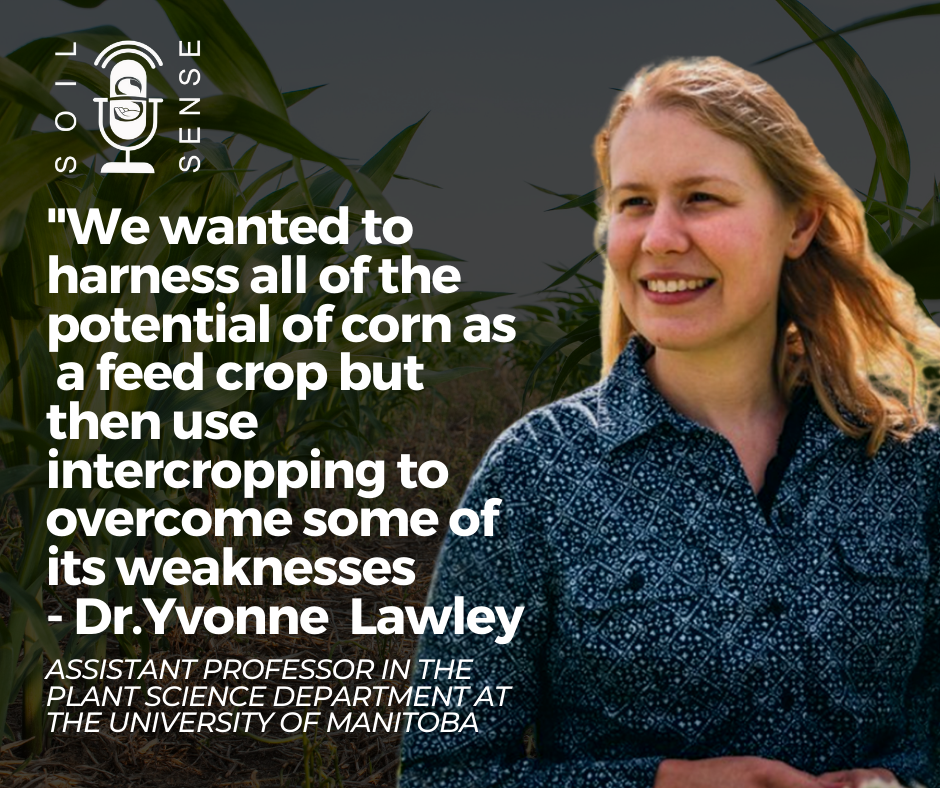
“We wanted to harness all of the potential of corn as a feed crop but then use intercropping to overcome some of its weakness.” – Dr. Yvonne Lawley
Today we focus on interseeding cover crops with forage quality in mind and exciting areas for ongoing research. We are joined by Dr. Marisol Berti, a professor in the Department of Plant Sciences at North Dakota State University, and Dr. Yvonne Lawley, an Assistant Professor in the Plant Science Department at the University of Manitoba.
“When people want to get into cover crops….we can’t really give you a recipe. We need to know what do you want the cover crops for? You know, if you want forage in the fall or forage in the spring, you’re going to have to change some practices.” – Dr. Marisol Berti
Dr. Berti found that intercropping corn with legumes such as alfalfa will provide a good forage and from a behavioral standpoint encourage the cattle to graze the field for longer periods of time in the winter because of a windbreak provided by the corn stocks. Unfortunately, there was not evidence of usable nitrogen left in the soil for the next crop. So if there isn’t the added benefit of nitrogen with interseeding, how do producers recover the added expense of cover crops while still providing forage?
“One way to get it back is when you raise cover crops, animals gain weight and that actually pays for the cover crops. So integrating with livestock really pays for the cover crops.” – Dr. Marisol Berti
Dr. Lawley shares that “science is exciting because one idea leads to a new question.” Many were surprised about the lack of nitrogen fixation after adding a legume to the corn crop. She shares that the research is ongoing and we are learning more about these fundamental processes which allow us to recommend agronomic adjustments. That in turn will allow for more accurate predictions of benefits and risks for producers.
This Week on Soil Sense:
- Meet Dr. Marisol Berti and Dr. Yvonne Lawley
- Explore the benefits of interseeding corn with forage type cover crops and find out how to get the most benefit out of the process
- Learn about ongoing research to understand the processes involved in this technique in production
Connect with Soil Sense:
Soil Sense Podcast is hosted by Tim Hammerich of the Future of Agriculture Podcast.
Episode 4: Cover Crops: Science, Practice, and Mindset


We have talked about cover crops a lot on this podcast. Today we speak with both a farmer and an extension agronomist about the decision-making required to introduce cover crops into an operation. Greg Amundson is a 4th generation farmer who farms with his dad near Gilby, North Dakota. Amundson began his venture with cover crops through an EQIP (Environmental Quality Incentives Program) with the NRCS. He explains how he approaches farming from a strict bottom line perspective when he says “I probably am a lower cost producer than anyone around. I don’t push for top yields. I push for the top return.”
“You don’t learn from your successes, you learn from your failures. So if you don’t fail, you don’t know if what you’re doing is right or wrong.” Greg Amundson
We are also joined by Greg Endres, a Cropping Systems Specialist with NDSU Extension. Endres focuses his efforts on bringing more data to cover crop decision making as cover crops are generally new to many productions. He hopes to make the information available to producers in order to make the most informed and beneficial decisions.
“If we have university data for people as a starting point for cover crops, that’ll give them a better chance of being successful with their cover crop and soil health program.” – Greg Endres
Endres shares that there is not a “one size fits all” to success with cover crops. Environmental factors and crop rotation considerations must be taken into account when making decisions about what cover crops to plant and when. “It all boils down to the amount of moisture and especially timely moisture,” explains Endres. While a cover crop can provide many benefits to the soil he cautions producers from discounting the amount of soil moisture the rye or other cover crop will take up and eliminate from any interseeded crops. One study is exploring the measurement of soil moisture to determine the rye termination date with the understanding that a poorly timed killing of the rye can adversely affect the yield of the main cash crop. While interseeding with a cover crop can present this risk of limited resources for crop yield, as always there are many apparent benefits to be factored in.
“The winter rye can serve as a substitute for a pre-emergence soil applied herbicide. So in other words, you can either use rye as a suppressant and terminate the rye when appropriate. That rye will hold back weeds quite nicely. And it can be a substitute for a soil applied herbicide…..So you’re trading management with herbicide usage.” – Greg Endres
This Week on Soil Sense:
- Meet Greg Endres, a Cropping Systems Specialist at NDSU Extension and Greg Amundson, a fourth generation farmer in North Dakota.
- Explore how Amundson approaches the addition of cover crops to his operation and the improvements he has observed
- Learn from Endres about ongoing research and factors that affect your cover crop selections and management
Connect with Soil Sense:
Soil Sense Podcast is hosted by Tim Hammerich of the Future of Agriculture Podcast.
Episode 5: Rock and Roll Agronomy with Jason Hanson
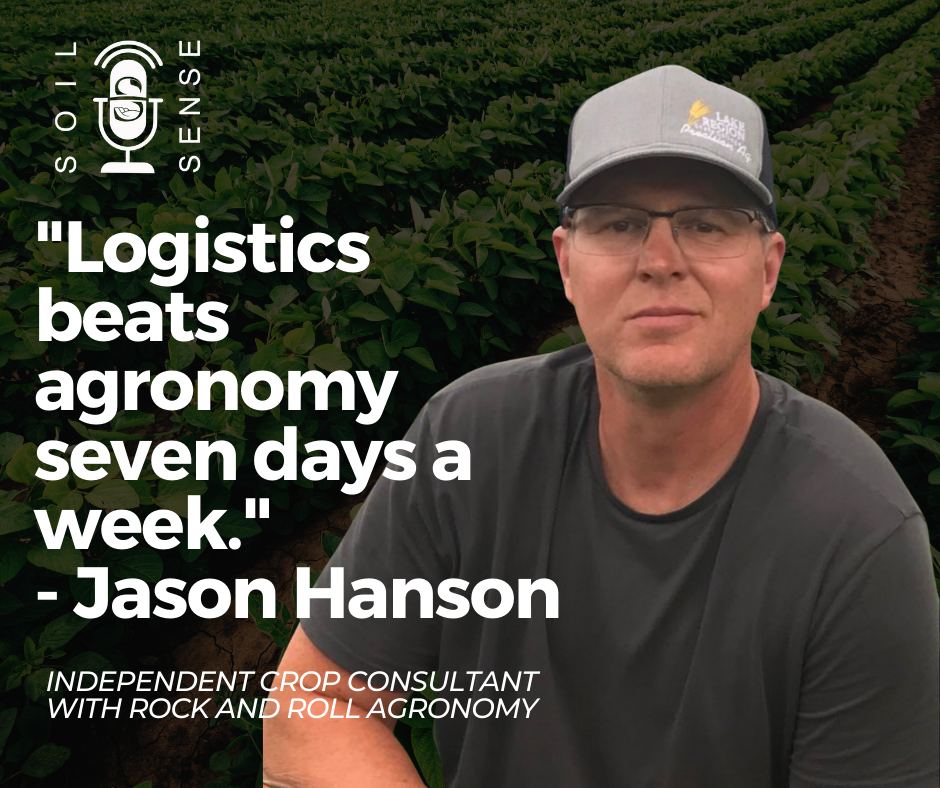
Agronomists play a significant role in following the progressive research in agronomic practices and assisting farmers in their operations. Jason Hanson is an Independent Crop Consultant with Rock and Roll Agronomy based in Webster, North Dakota. Jason has a long history of providing objective agronomic information to farmers and today he shares his take on what the role of his agronomist is. He also shares his perspective on cover crops which are slowly gaining popularity in his area.
“It’s about managing sunlight on the ground. It’s that simple. When it comes to weed control, that’s where a cover crop can come in and provide you part of that deal, so you don’t have growth. It’s just a different way of doing it. You’re not dumping something in the sprayer, you’re putting something in the air seeder to do that.” – Jason Hanson
Jason shares the importance of networking and forming relationships with scientists and producers in your area to learn about new ideas and technologies. He is forever learning and forever adjusting his recommendations based on the environmental circumstances producers are presented with.
“Logistics beats agronomy seven days a week.” – Jason Hanson
Jason adjusts his recommendations and expectations based on many factors just as the goals and opportunities of his producers are also dynamic. If a planting window shifts plans are adjusted to accommodate it. He sees the future of agriculture being an interest in inputs with regards to carbon levels and biological activity. “Everyone wants the quick easy answer…..and it’s complicated,” shares Jason.
“To me, that is the next step where ag is going. It’s going to be finding those things that we can use to enhance disease control, nutrient uptake, and yield potential, that are naturally occuring.” – Jason Hanson
This Week on Soil Sense:
- Meet Jason Hanson an Independent Crop Consultant with Rock and Roll Agronomy
- Learn about his approach to agronomy with his clients and with staying on top of ongoing research and developments
- Hear about what he thinks is the most significant benefit to cover crops
- Explore “Agronomy on Ice” and learn how to join your agronomic community
Connect with Soil Sense:
Soil Sense Podcast is hosted by Tim Hammerich of the Future of Agriculture Podcast
Episode 6: Educating the Next Generation with Ag Teacher Whitney Landman
![Soil Sense Quote-11[2]](https://www.ndsu.edu/soilhealth/wp-content/uploads/2020/10/Soil-Sense-Quote-112.png)
Agriculture teachers are responsible for not only teaching agricultural principles to the youth of today but also for encouraging their experience in agriculture and to promote leadership in whatever field they choose. Whitney Landman joins us from Larimore High School in Larimore, North Dakota. Whitney teaches both junior high and high school classes starting with introductory classes and ranging all the way to ag mechanics and community development.
“We always try to start with that intro level and exploring….so that we can bounce up into other concepts as well when they are older.” – Whitney Landman
Beyond the classroom, Whitney is also the FFA advisor. Her students are encouraged to participate in career development events and leadership development events. These events promote public speaking, leadership roles, agronomy identification and business management skills.
“The mission of agriculture education is to prepare students for successful careers and choices in the global agriculture, food, fiber and natural resource system…..So my goal, and I think a lot of teachers’ goal as they lead the ag ed program, is that our students find a career that they love, whether that’s in ag or not.” – Whitney Landman
Whitney highlights the importance of hands on experience for her students and the significant impact that can have on her students’ interest and concept understanding. She likes to see them “get active with the content” to encourage curiosity and excitement. Support from the NRCS helps her achieve these goals in allowing students to experiment with different soil health protocols including the effects of wind erosion and conventional tillage. She happily uses resources including local farmers to give her students more opportunity to see agriculture in action and learn skills they might not be able to gain otherwise.
This Week on Soil Sense:
- Meet Whitney Landman, an agricultural education teacher from Larimore High School in Larimore, North Dakota
- Learn about the many classes her program offers to its students
- Explore what she finds most effective for teaching new concepts to students
- Hear about the many collaborations she has engaged in to give her students the most opportunity to learn
Connect with Soil Sense:
Soil Sense Podcast is hosted by Tim Hammerich of the Future of Agriculture Podcast.
Episode 7: Grazing Management with Dr. Miranda Meehan
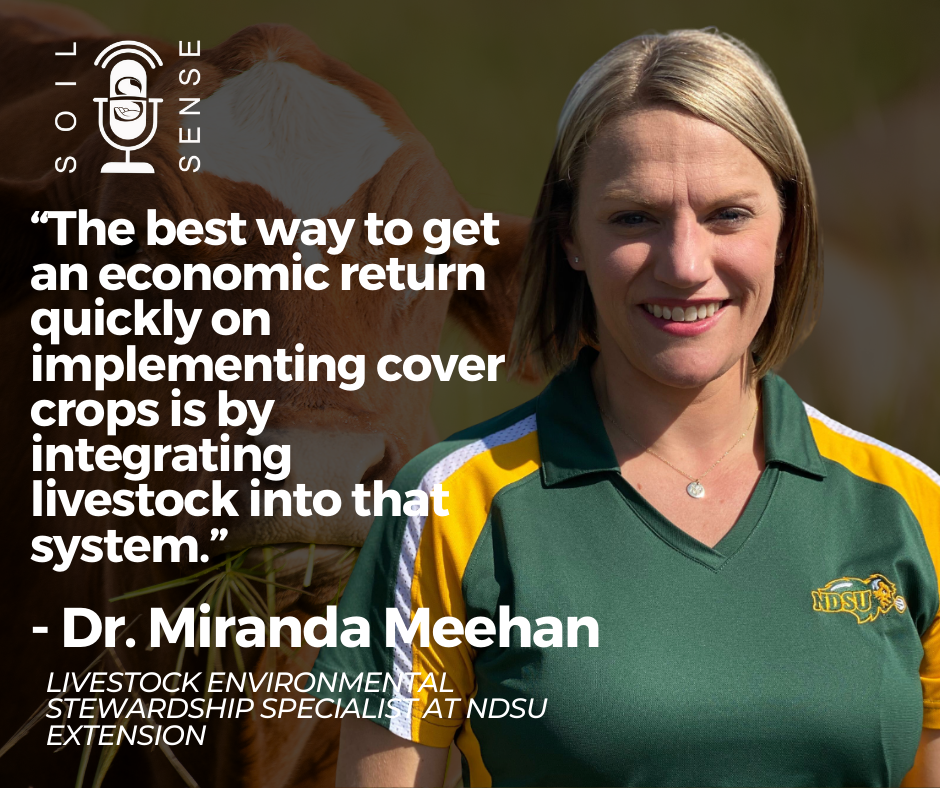
**Join us virtually at the DIRT Workshop December 8th – 9th: www.DIRTWorkshopND.com**
Incorporating livestock into your soil health program can seem daunting. Dr. Miranda Meehan is the Livestock Environmental Stewardship Specialist at NDSU Extension in the Animal Sciences Department. Her current research focuses on grazing management of cover crops. While cover crops can encourage soil health the return on investment may take some years to realize.
“The best way to get an economic return quickly on implementing or integrating cover crops is by integrating livestock into that system.” – Dr. Miranda Meehan
To date there isn’t a lot of research specifically focused on the impacts of grazing management within cover crop systems. Dr. Meehan is working on better defining some key factors to help producers plan out their options.
The terminology can be confusing but Dr. Meehan breaks it down for us. Stock density is the “number of animals per unit area.” Stocking rate is a “management decision on the number of animals we put out there” based on the number and type of cattle you intend to use. Carrying capacity is the available forage for those animals to graze. Dr. Meehan would like to be able to give farmers the list of soil health benefits as well as the economic benefits.
“We want to take a closer look at that so we could answer those questions and provide that information and hopefully enhance management within grazing cover crop systems.” – Dr. Miranda Meehan
Dr. Meehan recommends contacting your county extension agent to start determining the stocking rate and carrying capacity of your operation. There is also a grazing calculator app available on iTunes or Google Play that will help calculate some of those options. The county extension can also help you determine what cattle in what phase of production would best fit your cover crop options. Dr. Meehan recommends partnering with a livestock producer in your area when first trialing livestock management on cover crops and building from there.
This Week on Soil Sense:
- Meet Dr. Miranda Meehan, Livestock Environmental Stewardship Specialist at NDSU Extension in the Animal Sciences Department
- Explore what ongoing research is happening to better define livestock management options for grazing cover crops
- Discover how Dr. Meehan recommends starting this process on your operation
Connect with Soil Sense:
Soil Sense Podcast is hosted by Tim Hammerich of the Future of Agriculture Podcast.
Episode 8: Strategies for Keeping Living Roots in the Soil with Paul Thomas
![Soil Sense Quote-15[1]](https://www.ndsu.edu/soilhealth/wp-content/uploads/2020/11/Soil-Sense-Quote-151.png)
**Join us virtually at the DIRT Workshop December 8th – 9th: www.DIRTWorkshopND.com**
Finding the best fit for your operation takes consideration, planning and a willingness to try new things. Paul Thomas, a farmer near Velva, North Dakota, exemplifies these ideals. Paul joins us to discuss his experience with no till, growing lentils underseeded with alfalfa, trying an oat/pea intercop and relay cropping soybeans into spring wheat and oats. Paul reflects on what strategies have shown the most benefit for him and his farm.
“I think managing those crop rotations and having the right amount of residue on your soil and the right amount of residue to feed the biology in the soil is probably as important if not more important than even the tillage practice or seeding practice that you choose to use.” – Paul Thomas
Paul took over farming healthy soils from his father’s organic practices and has continued to try to build his soil organic matter, although he chose to do so without keeping all of the organic practices. Through cover crops, intercropping, and relay crops, he is attempting to keep living roots in his system as much as possible.
“If you just try and copy someone else’s system and that’s not where you’re really at, where your heart’s at or where your goals are at, it’s probably not going to work for you.” – Paul Thomas
Paul emphasizes the effects of having active root systems in his fields always. He highlights that it doesn’t have to have a lot of growth above the soil to provide benefit below the soil. Cover crops are what has been most beneficial for him. Some of his trials have gone as planned and some have not, relay cropping being one of them. He is rethinking that process and possibly introducing canola. Paul’s focus is efficiency and economics and with that in mind he will always be rethinking and tweaking his process to make his operation the best it can be.
This Week on Soil Sense:
- Meet Paul Thomas, a farmer near Velva, North Dakota
- Discover how Paul has incorporated different practices into his operation
- Explore the lessons he has learned and the choices he has made
- Learn about his philosophy towards farming with a focus on efficiency and economics
Connect with Soil Sense:
Soil Sense Podcast is hosted by Tim Hammerich of the Future of Agriculture Podcast.
Episode 9: Cultivating the Right Mindset with Monica McConkey, LPC
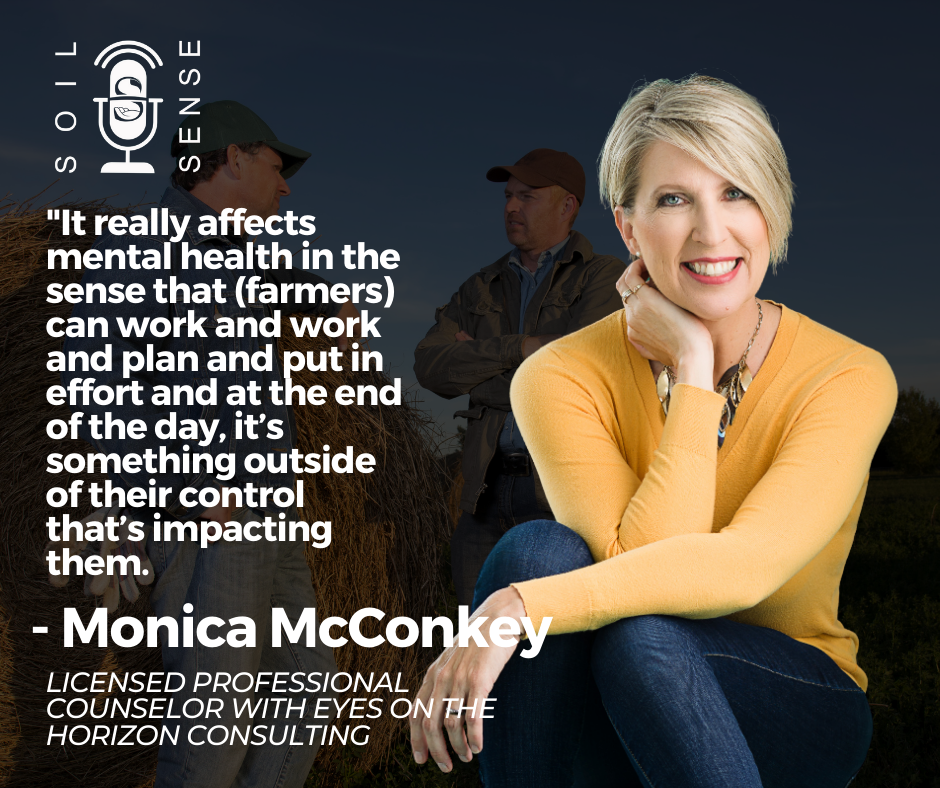
**Join us virtually at the DIRT Workshop December 8th – 9th: www.DIRTWorkshopND.com**
The right mindset isn’t just something you can set and forget. Farmers that choose to pursue soil health in their practices have changed how they view their relationship and impact on the soil. This mindset has to be maintained continuously over time. That goes for soil health, but it also goes for mental health as well. That’s the topic for today’s episode. Uncertainty, which is par for the course in agriculture, can really amplify stress and anxiety. Add on to that the desire to try new practices and a challenging economic environment, and you have a recipe for a very high stress environment.
Monica McConkey is a Licensed Professional Counselor (LPC) and rural mental health specialist with Eyes on the Horizon Consulting. Her main contract is with the farm business management program in Minnesota. This is a legislatively funded position involved with mental health outreach for farmers and farm families throughout the state. She meets with farmers several times per week helping them with the unique stressors that farmers face. Monica grew up on a farm and understands farming.
“Farmers are faced with so many uncontrollables, uncertainties and unknowns any of which can ultimately determine success or failure in their operation….That really affects mental health in the sense that they can work and work and plan and put in effort and at the end of the day, it’s something outside of their control that’s impacting them.” – Monica McConkey
Isolation, family dynamics and access to mental health care are additional pressures felt by rural communities. Oftentimes, these stressors are minimized as part of the agriculture experience. Monica recommends paying attention to those closest with you and if they have mentioned that “they are worried about you” or “you don’t seem the same as before” then perhaps it is time to reach out for help. Generally others will notice it about their peers before they can identify it in themselves. Disruption of baseline functioning in habits such as sleep, panic attacks, or interruptions in being able to do what you need to are all red flags for a struggling mental health.
“Our farmers are dealing with chronic stress, years of difficult commodity prices and some regulatory issues that some have dealt with. It’s just a difficult time. So it’s not like the changes happen overnight. It’s been years of accumulating stress that has caused them to be more isolating.” – Monica McConkey
Monica encourages her producers to focus on four main areas of their lives including physical health, mental health, social health and spiritual health. Making sure these core basics are being addressed and maintained first will improve overall functioning. Focusing on sleep and diet habits, having a support system, being more aware of your thoughts and the impact they have on your behavior, and fostering your beliefs will help build a foundation for support and self-care.
“So if there’s lessons to learn from the past or mistakes or regrets, take those lessons, but then you need to move in one direction and that’s forward. And there’s no easy trick for doing that. It is really intentional thinking.” – Monica McConkey
This Week on Soil Sense:
- Meet Monica McConkey, a rural mental health specialist with Eyes on the Horizon Consulting
- Discover how rural mental health presents its own unique challenges
- Explore the different ways intentional thinking can affect your day to day functioning
- Learn about how to find resources in your community and reach out if you think you might benefit from some additional help
Connect with Soil Sense:
Soil Sense Podcast is hosted by Tim Hammerich of the Future of Agriculture Podcast.
Episode 10: Managing Low pH Soils with Ryan Buetow and Nathan Thomas
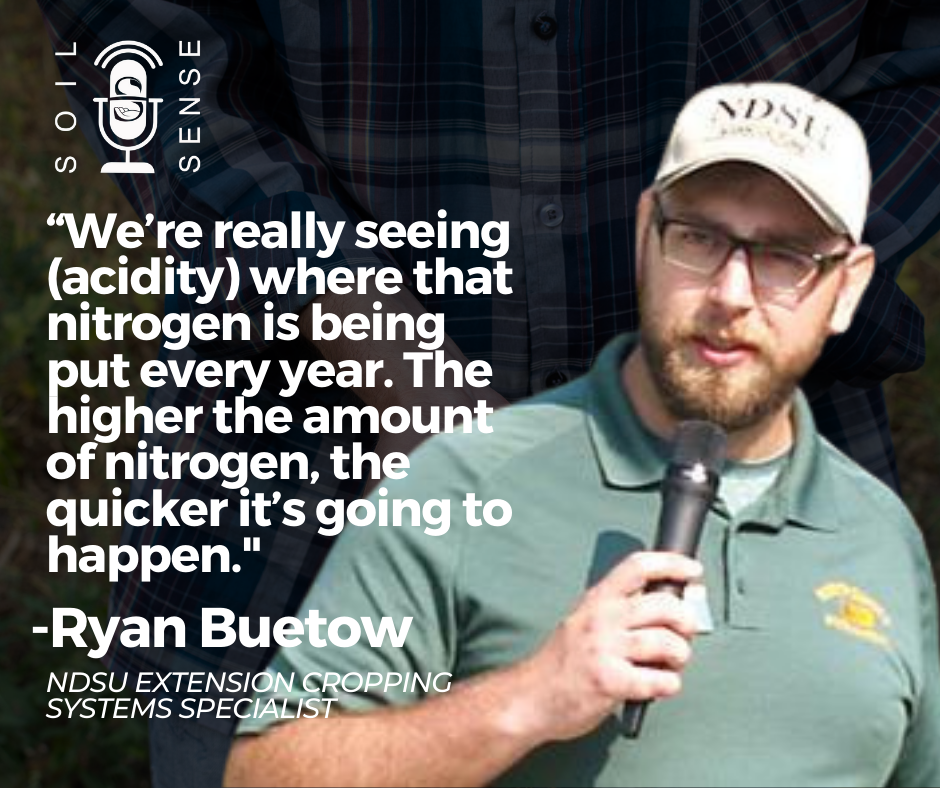
**Join us virtually at the DIRT Workshop December 8th – 9th: www.DIRTWorkshopND.com**
“What can I do to correct low pH in no-till systems in a corn/soybean rotation? Here in southeast South Dakota, we’ve got a lot of low pH areas and fields and it is a pretty big challenge to get them corrected.” – Brad Farrell
To answer this question, we are joined by Nathan Thomas, a fourth generation farmer from southwest North Dakota, and Ryan Buetow, a NDSU Extension Cropping Systems specialist based out of the Dickinson Research Extension Center. Nathan and Ryan have been collaborating to manage the low pH on Nathan’s farm and share their findings and plans going forward.
“We’re really seeing (acidity) where that nitrogen is being put every year. The higher the amount of nitrogen, the quicker it’s going to happen especially at the edges of the field where they are turning around and maybe accidentally putting on twice the amount of nitrogen.” – Ryan Buetow
This has generally gone unnoticed over the years because most soil testing involves a deep sample which may dilute the acidic pH that is found closer to the surface of the soil. Decreasing unnecessary nitrogen applications, increasing organic matter and trying humic acid inputs are the many strategies Nathan is trying to increase the pH in the soil. Acidic pH allows for a more significant bioavailability of the aluminum and manganese naturally found in soils to the crops. Some crops seem to be more sensitive to these soil chemistry changes than others. Lime applications are the typical treatment for acidic soils but are less effective without the physical incorporation of tilling it into the soil which creates an additional challenge for no-till operations.
“We started to look into lime right away, and we found three available sources that we could use (pellet, sugarbeet, water treatment). They all have positives and negatives.” – Nathan Thomas
This Week on Soil Sense:
- Meet Nathan Thomas, a farmer in southwest North Dakota, and Ryan Buetow, a NDSU Extension Cropping Systems specialist
- Explore what causes acidic soils and how that can affect crops
- Discover the challenges of treating acidic soils especially in no-till systems
Connect with Soil Sense:
Soil Sense Podcast is hosted by Tim Hammerich of the Future of Agriculture Podcast.
Episode 11: The Importance of Extension with Dr. Greg Lardy
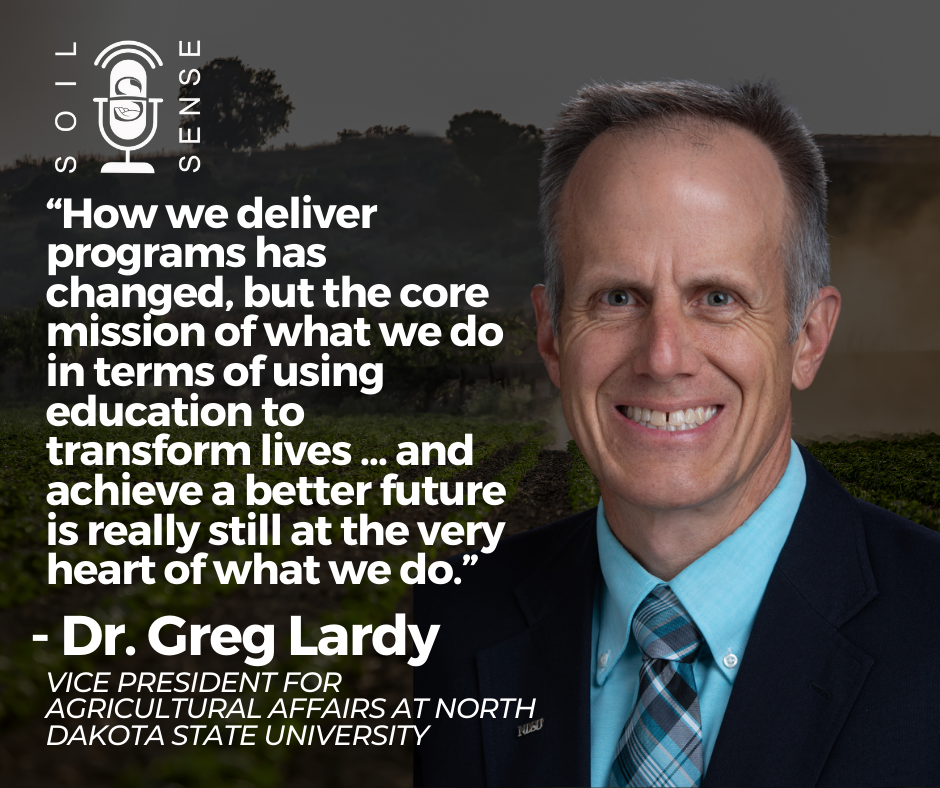
**Join us virtually at the DIRT Workshop December 8th – 9th: www.DIRTWorkshopND.com**
The extension has a rich history in keeping producers informed and up to date. Dr. Greg Lardy has seen the growth and expansion of these programs and gives us insight into what makes the extension valuable and how it is adapting to the changing times. A beef cattle nutritionist by training, Dr. Lardy is currently the Vice President for Agricultural Affairs at North Dakota State University. In this capacity, he serves as the Dean of the College of Agriculture, Food Systems, and Natural Resources; the Director of the NDSU Extension, and the Director of the North Dakota Experiment Station. So basically day-today he is tasked with managing all activities that relate to agriculture at NDSU.
“How we deliver programs has changed, but the core mission of what we do in terms of using education to transform lives and help people see a better future and achieve a better future is really still at the very heart of what we do” – Dr. Greg Lardy
Dr. Lardy remembers as a child visiting the extension building to find a wall of printed bulletins that producers could look through to find answers to their questions. Producers are now accessing internet sources to find these answers. Keeping research and information more readily accessible has been a priority for the extension program whether that be online, in person or in printed material. Beyond offering the information, Dr. Lardy also emphasizes the importance of creating measurable metrics to identify the efficacy of the information being shared. Going forward, Dr. Lardy sees the need for a continual and perpetual push for connectivity with producers and consumers.
“Even though we are engaged right now with stakeholders, we’ve got to be more engaged with listening to the needs of our constituents and taxpayers out there. What are they saying? What do they need to help them live better lives across the state of North Dakota?” – Dr Greg Lardy
This Week on Soil Sense:
- Meet Dr. Greg Lardy, Dean of the College of Agriculture, Food Systems, and Natural Resources and the Director of the NDSU Extension
- Explore the core mission of the Extension Program and what it offers producers
- Discover how the program is continually evolving to be more accessible and stay relevant with producers and their needs.
Connect with Soil Sense:
Soil Sense Podcast is hosted by Tim Hammerich of the Future of Agriculture Podcast.
Episode 12: Bale Grazing with Erin and Drew Gaugler
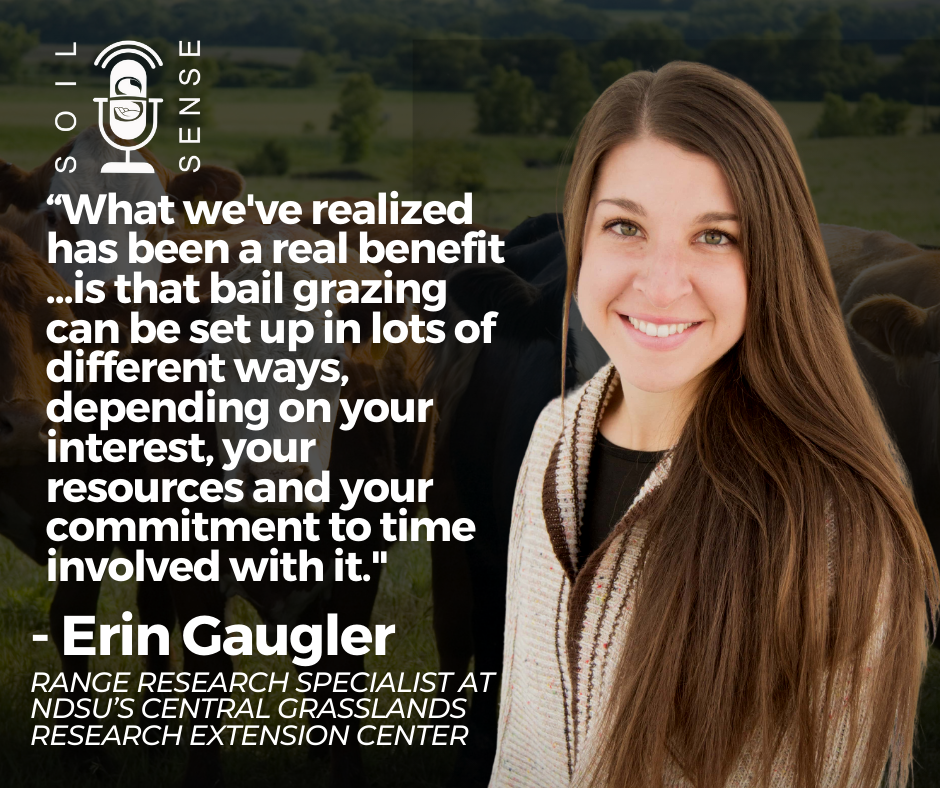
**Join us virtually at the DIRT Workshop December 8th – 9th: www.DIRTWorkshopND.com**
Interest continues to rise in incorporating livestock into production systems. Through funding from a SARE grant, brother and sister duo Erin and Drew Gaugler have been experimenting with bale grazing. We talk about their findings from implementing this approach, including how it has impacted soil health and the performance of their cattle.
Drew returned to the family ranch in southwest North Dakota after working in oil fields around the world. Erin works full time as a Range Research Specialist at NDSU’s Central Grasslands Research Extension Center near Streeter and is still actively involved in the operation. They applied for a grant from SARE (Sustainable Agriculture Research and Education program) to implement and evaluate a new bale grazing technique.
“I guess what we’ve realized has been a real benefit …is that bail grazing can be set up in lots of different ways, depending on your interest, your resources and your commitment to time involved with it, or wanting to have less to do with it.” – Erin Gaugler
Sections are isolated with temporary fencing and rotated to concentrate and control the cattle’s effects on the field. The initial goal for the operation was to reduce feeding costs for cattle. Drew has observed soil health benefits, a reduction in labor costs and an improvement in the cattle behavior and stress levels. Initially there was concern that the left over residue would hinder future perennial crop growth if not redistributed. However, Drew shares that the residue left from the hay has not required any additional management and has encouraged perennial crop growth.
“On one soil test spot it had roughly three pounds of available nitrogen per acre and the direct bale grazing response went to 70 pounds of available nitrogen per acre. That’s a drastic spot but that was to show how change can be fueled.” – Drew Gaugler
While not every location experienced that marked of an improvement, overall both Drew and Erin observed impressive results by virtue of added organic material and bale residue. In addition to soil health, another benefit is the flexibility of this system which could allow a producer to focus on bale grazing efforts only a couple days a week giving them the opportunity to pursue other goals concurrently.
This Week on Soil Sense:
- Meet brother and sister team Drew and Erin Gaugler. Drew operates the family farm in southwest North Dakota and Erin works as a Range Research Specialist at NDSU
- Explore their experimentation with incorporating livestock into production systems
- Discover the benefits they’ve observed from soil health, to overhead, to cattle behavioral improvements
Connect with Soil Sense:
Soil Sense Podcast is hosted by Tim Hammerich of the Future of Agriculture Podcast.
Episode 13: Transitioning the Farm to the Next Generation with Kari Olson

While no-till and cover crops are slowly gaining popularity, the Olson operation has been pursuing their practices for 17 years. As though that doesn’t make their operation unique enough, Kari Olson is a young female farmer who got the opportunity to farm her own ground early on shortly after graduation. While some have underestimated her abilities she has proven herself and continues to expand and learn all she can from her dad as he transitions the family land to her charge.
Kari has participated in the cafe talks with Dr. Abbey Wick. Because of those discussions she went on to explore different cover crop species, techniques and even saved some of her rye for seed to reduce the risk of added weed populations. She has also recently hired someone to manage cattle grazing her cover crops to enhance the soil health of her fields and increase their organic material.
“We’ve been soil testing every third year and, you know, watching the rates of nutrients and they’re staying up there. We still have to fertilize, but we’re starting to cut back on that. Organic matter isn’t decreasing anymore. It’s starting to slowly increase.” – Kari Olson
One problem she is trying to mitigate is the temperature of her soils which caused her corn emergence to be off. She attributes this to the residue remaining on the surface and blocking sun exposure. New equipment and new cover crops are all on the horizon to manage this issue.
While she feels they haven’t achieved all the potential they will with their soil health, she has noticed a difference in the soil structure. She found the fields much more consistent and easier to manage. Kari hopes to not only preserve the ground she has been trusted with but to continue to improve it so that future generations will have the opportunities that she was able to find and take advantage of.
This Week on Soil Sense:
- Meet Kari Olson, a young beginning farmer, who shares her perspective on soil health and the practices her operation uses
- Explore Kari’s experience with cover crops and no-till
- Learn about the challenges she has faced and the adjustments she has made
Connect with Soil Sense:
Soil Sense Podcast is hosted by Tim Hammerich of the Future of Agriculture Podcast.
Episode 14: Interstate Collaboration with Bill Spiegel and Dr. Abbey Wick
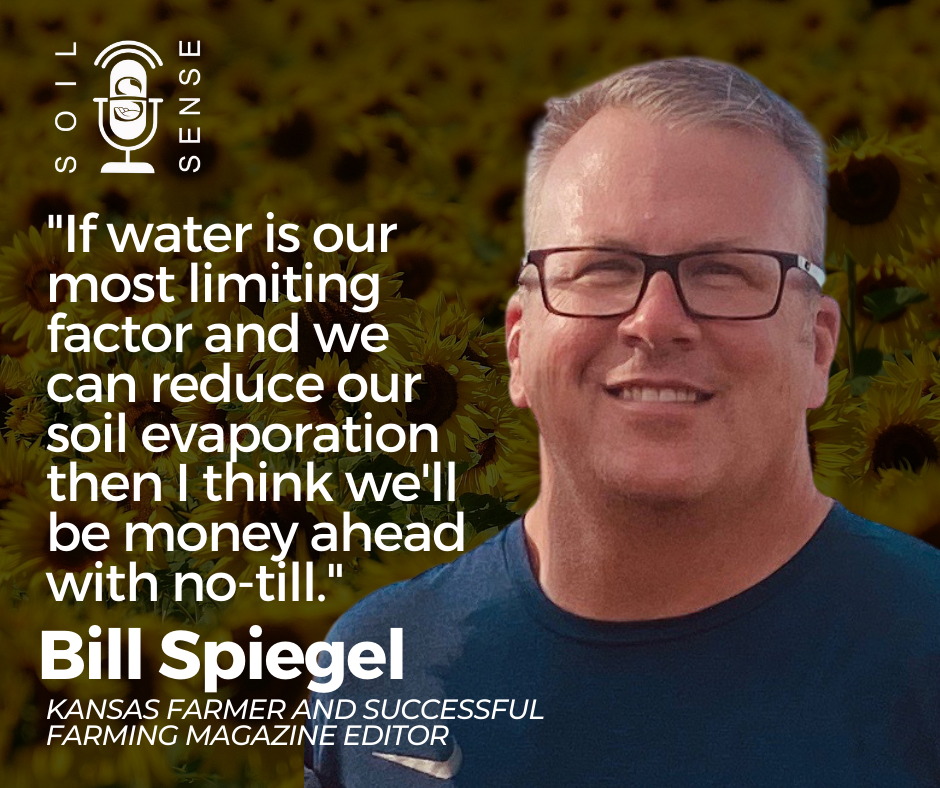
Bill Spiegel is on the show today. You may know him as the Crops Editor for Successful Farming Magazine but he is also a farmer and soil health advocate. Over the last 20 years he has worked to eliminate tillage and incorporate cover crops into his operation in Kansas. Dr. Abbey Wick also joins us from the NDSU Extension to reflect on her collaboration with Bill. When he first started to explore soil health, Bill had to convince his dad.
“No-till just seemed to make sense because we’re in about a 24 inch rainfall area and so water was always our limiting factor….. I think at that time I kept hearing anytime you pull a disc through the field, you’re going to lose two inches of soil moisture. So…. if that’s our most limiting factor and we can reduce our soil evaporation and transpiration then I think we’ll be money ahead” – Bill Spiegel
Bill has since added cover crops to his rotation which at the time of his first attempt was considered a very “unique” practice. His hope with cover crops was to increase yields but the surprising unexpected benefits included much better weed control and a significant decrease in soil erosion. Bill found support in his soil health practices in Abbey Wick even though she is in North Dakota and not nearby his Kansas operation.
“The great part of soil health is just the culture of soil health and the ways that farmers, researchers, extension and consultants, like we say, for this podcast, the way they all interact.” Dr. Abbey Wick
Bill echoes Dr. Wick’s sentiment. He found that the support and community he experienced when he started engaging with others involved in promoting soil health practices was “cool” and “unique.”
This Week on Soil Sense:
- Bill Spiegel is a farmer and Crops Editor for Successful Farming Magazine
- Learn about Bill’s introduction to no-till and his experiences with its practice
- Discover the many ways Bill has continued to encourage the health of the soil on his operation with cover crops and grazing efforts
- Explore the collaboration opportunities within the soil health community
Connect with Soil Sense:
Soil Sense Podcast is hosted by Tim Hammerich of the Future of Agriculture Podcast.
Episode 15: DIRT Workshop Roundup: Strip Tillage, Cover Crops, Relay Crops, and Grazing

This is our final episode of season three. What a great season it has been! To close out season three, we wanted to bring you a highlight reel from the recent DIRT workshop. However, with two full days of material and dozens of experts weighing in on a variety of topics – there was no way to condense things down to a 30 minute Soil Sense episode. So instead, I chose to pull clips from four different individuals, each of which weighed in on a different panel during the DIRT Workshop.
Today’s guests were chosen not only for great information and stories, but also because they have not yet been featured on this podcast.You’ll hear from Steven Schuster, a farmer in Minto, North Dakota, talking about strip tillage, then will hear from Stefan Gailans, who is with the Practical Farmers of Iowa talking about cover crops, then Russ Gesch from USDA ARS based out of Morris, MN who shared about relay cropping, and will finish today’s episode with rancher Jerry Doan from McKenzie, ND who describes some of this practices grazing cover crops.
“It’s not necessarily about getting the highest yield. It’s about having the most profit from the yield that you are getting, and controlling risk.” – Steven Schuster
“A living cover crop is still standing up. Those row units can move through that a little better, so that they don’t plug. They can cut through the cover crop in the soil, get good depth control, and cover up that furrow again.” – Stefan Gailans (on planting soybeans green)
“We call these winter oilseed ‘cash cover crops’, because we’re wanting to harvest them to tap into new markets, but also getting those environmental benefits of using it as a cover crop.” – Russ Gesch, Ph.D. (on relay cropping camelina/soybean)
“When I was growing up, it was wheat and summer fallow, and half of that soil is in South Dakota because that’s where it blew back in those days. And I didn’t know if we could bring those soils back…and we’ve been really impressed by how we ARE bringing those back.” – Jerry Doan
This Week on Soil Sense:
- Steven Schuster, farmer from Minto, ND talks about strip tillage
- Stefan Gailans, research and field crops director for the Practical Farmers of Iowa talks about cover crops
- Russ Gesch, Ph.D., research plant physiologist with USDA ARS in Morris, MN on relay cropping camelina
- Jerry Doan, rancher from McKenzie, ND on grazing cover crops
Connect with Soil Sense:
Soil Sense Podcast is hosted by Tim Hammerich of the Future of Agriculture Podcast.